
|   |

|   |
The glory of being Kelubabu - Veejay Sai e-mail: vs.veejaysai@gmail.com Photos courtesy: Arabinda Mahapatra September 15, 2013 Every year the Guru Kelucharan Mohapatra Award festival is usually the most looked forward to on the cultural calendar of Odisha. For someone who not just dedicated his life for the Odissi dance form, but made it a global art worth consuming in leaps and bounds, this is a small honour the land bestows in gratitude to its very own son of the soil. This time around the festival entered its 19th year and had yet another wonderful set of surprises. What is excellent about the organizing and administrative thoughts of Guru Ratikant Mohapatra is he programs a good dosage of dance and music in equal measures, unlike most other festivals done in the memory of dance gurus. The present review covers only the dance elements of the festival. Mystical moves and magical moods 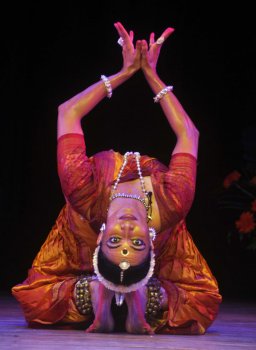 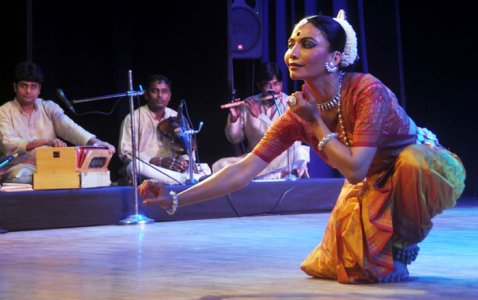 Bijayini Satpathy Even as the state mourns the sad demise of the legendary Pt Raghunath Panigrahi, there couldn’t have been a better tribute to the late maestro on Teacher’s Day. The first evening opened with a solo Odishi recital by Bijayini Satpathy from Nrityagram. The festival couldn’t have opened on a better note. Bijayini who is the grand-shishya (shishya’s shishya) of Kelubabu and was fortunate to be the chosen one for Pt Raghunath Panigrahi’s last musical works, set the mood for the evening going just fine. Bijayini began the evening’s performance with ‘Parvathi Panchakam’ an excerpt from the Brihatstotra Ratnakara. Everyone is well aware of Adi Shankara’s famous ‘Shiva Panchakshari Stotram’ but an obeisance to his consort wasn’t too common on the dance stage. Choreographed by Surupa Sen as a part of their ‘Samhara’ collaboration with Sri Lankan dancers, Bijayini performed it as a solo and opened the evening on a graceful note. She continued into a Vasanta Pallavi composed by Pt Raghunath Panigrahi. Surupa Sen had urged Panditji to create a Pallavi set to his favourite raga and choreographed this as part of her show called Sacred Space and dedicated the Pallavi to him. The magic of the music created by the late maestro mixed with the poetic choreography of Surupa came together like a combination in heaven. A thousand springs blossomed to welcome rasikas on to a joyous journey. An old famous Ghalib Sher goes: "sab kahaan kuch lala-o-gul mein numaayaan ho gaye Khaak mein kya suratein hongi ki pinhaan ho gaye" (Many die and mingle into the dust of time. A few return from the earth as spring blossoms) This can be said true of Panditji too. Though he is no longer around with us physically, he will continue to return every time his music and compositions are sung. He remains immortalized in them and they are a witness to his prolific genius. Bijayini continued her performance with the classic ‘Manasija manamohana’ a composition of poet Gopalakrishna. “We heard him sing this song often during his stay with us,” says Bijayini. The composition is a sweet story of Radha recounting a sakhi her vision of playful Krishna. Bijayini’s abhinaya matched the childlike role Krishna plays while teasing Radha. With excellent flute music by her own brother Srinibas Satpathy and mardala by another brother Shivshankar Satpathy, Bijayini was at a double advantage. When was the last time the dance stage saw such accompaniments? As a senior rasika pointed out, it reminded one of Vishwanathan playing the flute and Ranganathan playing the mridangam as the legendary Balasaraswathi took audiences by storm with her divine dance. Bijayini concluded her performance with ‘Shivashtakam’ which was choreographed by Surupa in 2005 as part of ‘Ansh.’ Lynne Fernandez’s lighting design was exceptional as Bijayini slowly twirled around in the concluding shloka ‘Dhyayena nityam mahesham.’ The second part of the evening was a solo tabla performance by Pt Nayan Ghosh with the support of the harmonium lehra provided by Hiranmay Mitra. Opening with a ‘Teen Taal’ to raag Kirwani, Nayan exhibited the virtuosity of his fingering technique and an excellent selection of variations from all the various gharanas he belongs to. Flying eyebrows and sweating peacocks 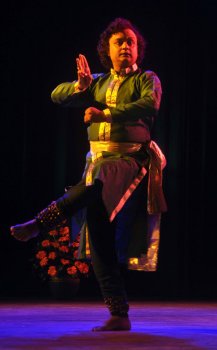  Deepak Maharaj A loud clanker of anklets accompanied by a louder clatter of tapping feet rang through the Rabindra Mandap in the evening’s first performance. Deepak Maharaj, son of Pt Birju Maharaj, presented a Kathak solo way ahead of everyone’s expectations from him. He introduced the evening with reminiscing about the time when Kelubabu enacted a nayika opposite Maharaj-ji as Krishna in a unique jugalbandi they performed many years ago. Opening his performance with ‘Ardhanarishwara’ set to raag Bhoopali and rupak taal, Deepak began exhibiting the virtuosity of his footwork right from the word go. While his tatkaar was highly impressive, his constant raising his eyebrows was a distraction. So much so the effect of his ‘Ardhanarishwara’ was watered down drastically. At some point one had to struggle to find out if the flying brow belonged to the Shiva-half or the Shakthi-half of the deity. Raag Bhoopali sung by Anirban Bhattacharya also distorted into an unknown tune with liberal doses of ‘Nishaad’ and ‘Madhyam’ drifting in and out for no apparent reason. Deepak continued into demonstrating various ‘Upaj’ in Teen Taal beginning with a Lehra in raag Vasant. From gopikas craving for Lord Krishna, sounds emanating from Shiva’s damaru, Swapneshwar Chakravarthy’s sitar and Anil Mishra’s sarangi accompaniments saw him through this. After much complaining about the humidity in the hall and seeking forced applauses from the audience, Deepak continued with displaying various ‘gats’: the one bereft of the syllable ‘dha’ called ‘Bagair dha ki gat’, Maharaj-ji’s composition that sequences ‘Thirkita thirkita ghena’ and so on. His display of the sound of temple bells was lost in the increasing decibels and turned out more like a demanding school bell ringing disproportionately loud. In the jugalbandi between his anklets and tabla, Deepak exhibited his virtuosity in taal but the demand on one’s ears was too much to expect with constant increase in the volume of the speakers. Many subtle sounds of the ankle bells were lost out in the process. Singing a traditional composition of Bindadin Maharaj of Lucknow Gharana, ‘Tori main na manungi,’ one got a glimpse of how good a singer Deepak is. With a slight crack in his voice, he sang ‘jhooti batiyan karat’ and attempted to portray the mood through his abhinaya. However, he barely managed to strike a balance with his impressive voice and his abhinaya with his flying eyebrows. After some more complaints about the heat in the hall, Deepak continued his performance and displayed ‘Mayur ki gat’ or the dance of a peacock. In wild abandon, just before the arrival of rains, Deepak sweated his way through portraying overcast skies, thunder and lightning and the dance of the peacock. Deepak concluded his performance with his famous ‘Na dhin dhinna’ piece where his cross-legged footwork always brings him a good round of applause. Pranshu Chaturlal (the grandson of the legendary Pt Chaturlal) was outstanding in his tabla accompaniment. He is surely one of the promising guys to look out for in the times to come. The second part of the evening had a Hindustani vocal concert by Pt Ulhas Kashalkar with support on the tabla by Pt Suresh Talwalkar. Pining nayikas and perfect poses 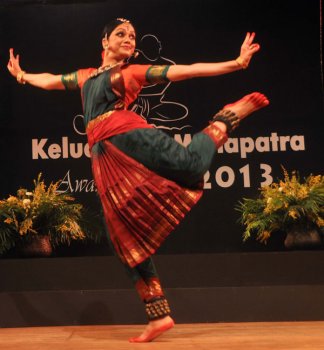 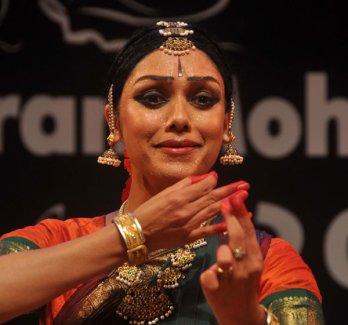 Rama Vaidyanathan On the fourth day of the festival, the evening opened with a solo Bharatanatyam recital by Rama Vaidyanathan. She began her performance with the ‘Mayura Alaripu’ that she has made popular of late. The piece has almost become like her signature tune to begin her concerts. As the power packed jatis rendered by Karaikudi Siva Kumar filled the hall, Rama pranced about like a peacock in wild abandon and the Alaripu was an instant hit with the audience. Rama followed that with a Swati Thirunal kriti “Pannagendra Sayana.” Designed to be an Ashtaragamalika, Rama’s smart choreography turned it into a varnam. The whole song narrates the story of a nayika pining for Lord Padmanabha, in eight statements. The excellent composition begins in ragam Shankarabharanam and like a sumptuous eight-course meal, takes you through Kamboji, Neelambari, Bhairavi, Todi, Surutti and Nadanamakriya before it reaches Bhoopalam and does a full circle back to Shankarabharanam. While each line had its own beauty, Rama’s abhinaya was a delight to watch in intermittently. If the nayika began her craving for the lord by requesting him not to be angry with her in Kamboji’s ‘Mandamaarutopi mama manasam,’ one could see how even the nature of her sakhis provoked that further in Bhairavi’s ‘Maaninijanahasitam makuri manamayesam’. However one felt the movement could have been less racy in the sancharis exhibiting the gait of a majestic elephant in the later part of the kriti. Laying the whole kriti threadbare into eight segments, Rama’s choreography for each of the lines was a fine work of a thinking artiste. Not being too direct and yet conveying the essence of the composition, the pure dance sequences mingled with the abhinaya effortlessly. It was a delight to see Rama’s return to the first line ‘Pannagendra Sayana’ to make a transition to the next as the sequence progressed. K. Venkateshwaran’s vocal support was outstanding. The ease with which he strode from one ragam to another in this challenging composition was impressive. Rama concluded her performance with a Purandhara Dasa kriti depicting a lovelorn nayika’s playful tease with Lord Krishna. Once again, she breezed in with her portrayal of the whole narrative being a delightful exhibit. The grand soul song of India 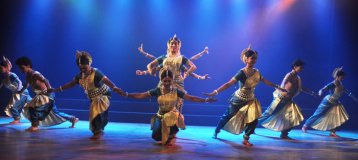 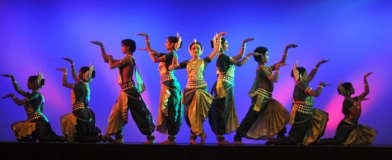 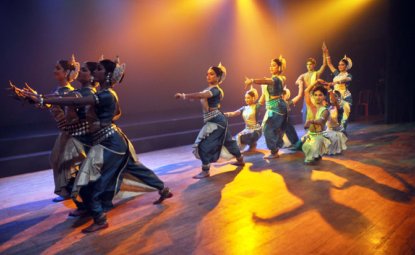 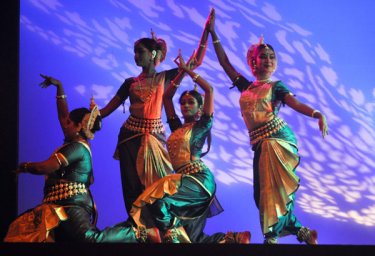 Srjan Repertory The grand finale of the festival was a presentation by Srjan with ‘Gitamritam,’ a choreography based on the Bhagawad Gita conceptualized by Guru Ratikant Mohapatra. The story of the Bhagawat Gita is not an unknown one nor is it new to the dance stage. It is probably the most told one by every possible dancer, guru, dance school and institute. But what was different in Ratikant’s production was the high quality of aesthetics that was presented. No character costumes, no frills and no melodrama. What unfolded was a refined summary of the eternal song. When such a large text is at disposal, the biggest trauma facing a scriptwriter is what to keep and what to leave out, not affecting the overall quality of the production. Nityananda Mishra’s scholarship on the subject came through and through in the smart editing of his script. Everything important was there and yet it was not cluttered with an overdose of what the Gita or the language of Sanskrit can do to you. No show on the Odia stage (including the loud and filmy Jathra) opens without the inevitable obeisance to Lord Jagannatha. However, a differently tuned ‘Kadachid Kalindi’ with sitar by Rabi Shankar Pradhan and sarod by Sunando Satpathy (both of which were to play a significant role in the orchestration throughout the show) was refreshing to listen to from the old one. Opening with depicting sage Vyasa penning the tome, the choreography of forming a frieze to the point in which the battle lines were drawn between the Pandava and Kaurava brothers, the show began with much excitement. Arjuna’s (performed by Bijaylaxmi Satapathy) rightful dilemma about fighting his own family members and Krishna (performed by the petit Rajashri Praharaj, a little too short for the majestic character) solving it with his sermon, a visual spectacle awaited everyone. The entry of a large chariot from the right wing onto the stage had everyone gasping in awe. Constructed totally out of dancers (we have our very own Odia Pilobolus!) the whole mural was visually arresting. Using an old theatre technique of having an elevation to create a different level of the stage (both the legends Vijay Tendulkar and Habib Tanvir often used this in most of their productions) as the Pandavas and Kauravas stood in the background, facing each other, ready to start a war, in the forefront were Krishna and Arjuna having their dialogue. The inevitable ‘Vishwaroopam’ couldn’t have been done with more aesthetics for a group presentation. As the familiar ‘Karmanyevaadhikaarasthey’ and popular ‘Yada yada hi dharmasya’ went on air and the crescendo built up, the visual imagery created on stage was spellbinding. Except for the music, which could have been tapered down in its overall orchestration, one couldn’t help but stay in awe with the quality of the production. The high quality of lighting by the expertise of Jayadev Das and Debiprasad Mishra (everyone’s favourite Tikki!), the characters and the philosophy of the subject came alive on stage. The soulful music, brainchild of Pt Raghunath Panigrahi and Pt Bhubaneswar Mishra with inputs by Satyabrata Katha recreated the magic of the Gita all over again. This is certainly a production that needs to travel far and wide. As a senior rasika said, “If the big heads of all the cultural exchange programs like the ICCR had seen it, by the end of the show, they would have blindly offered this production a multi-country tour.” With excellent coordination among their artistes, precision and clarity of thought, this production once again proved what a fine guru Ratikant Mohapatra is. Three cheers to Srjan for such a grand display of their artistry! Veejay Sai is a writer, editor and a culture critic. |